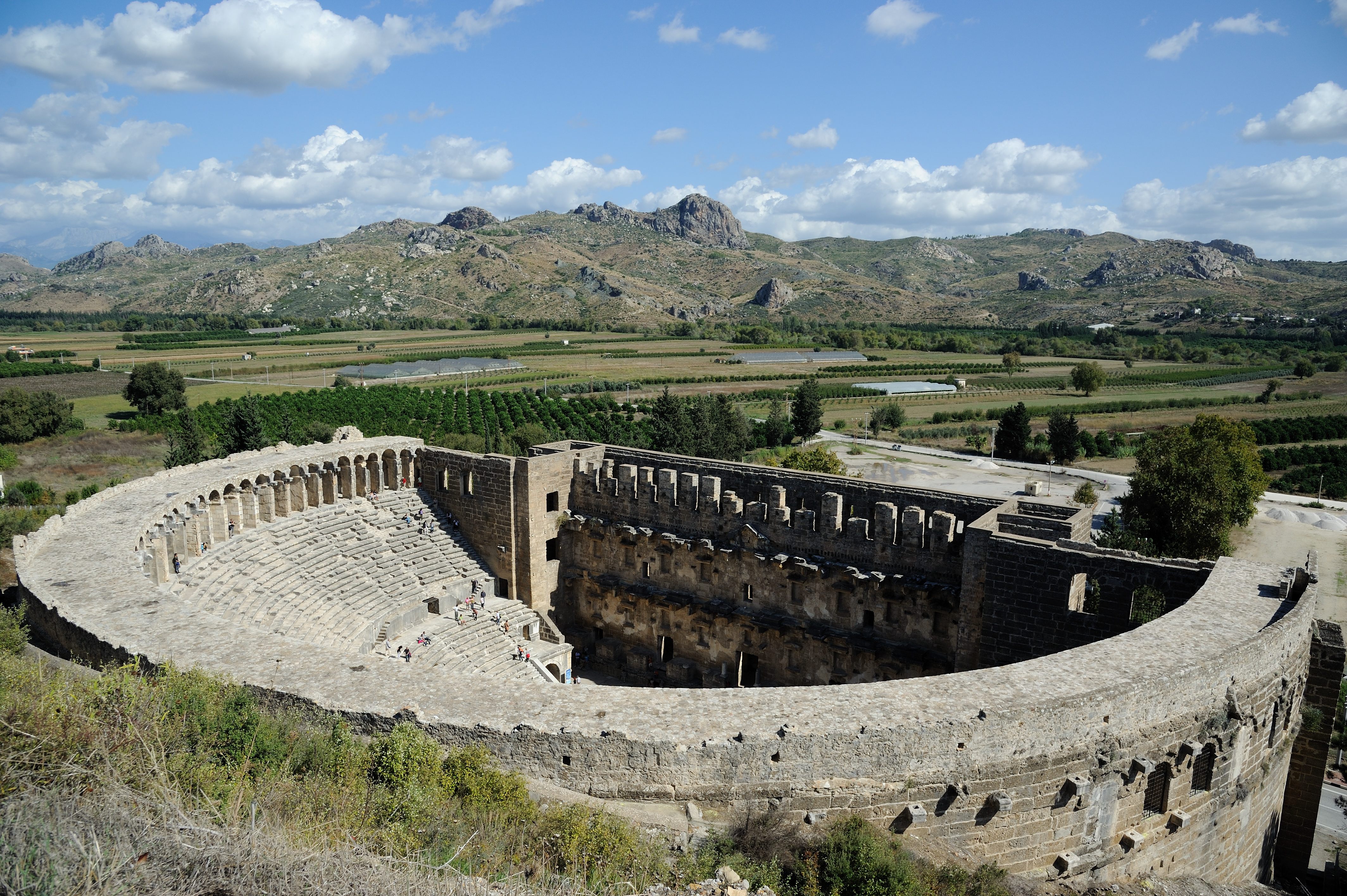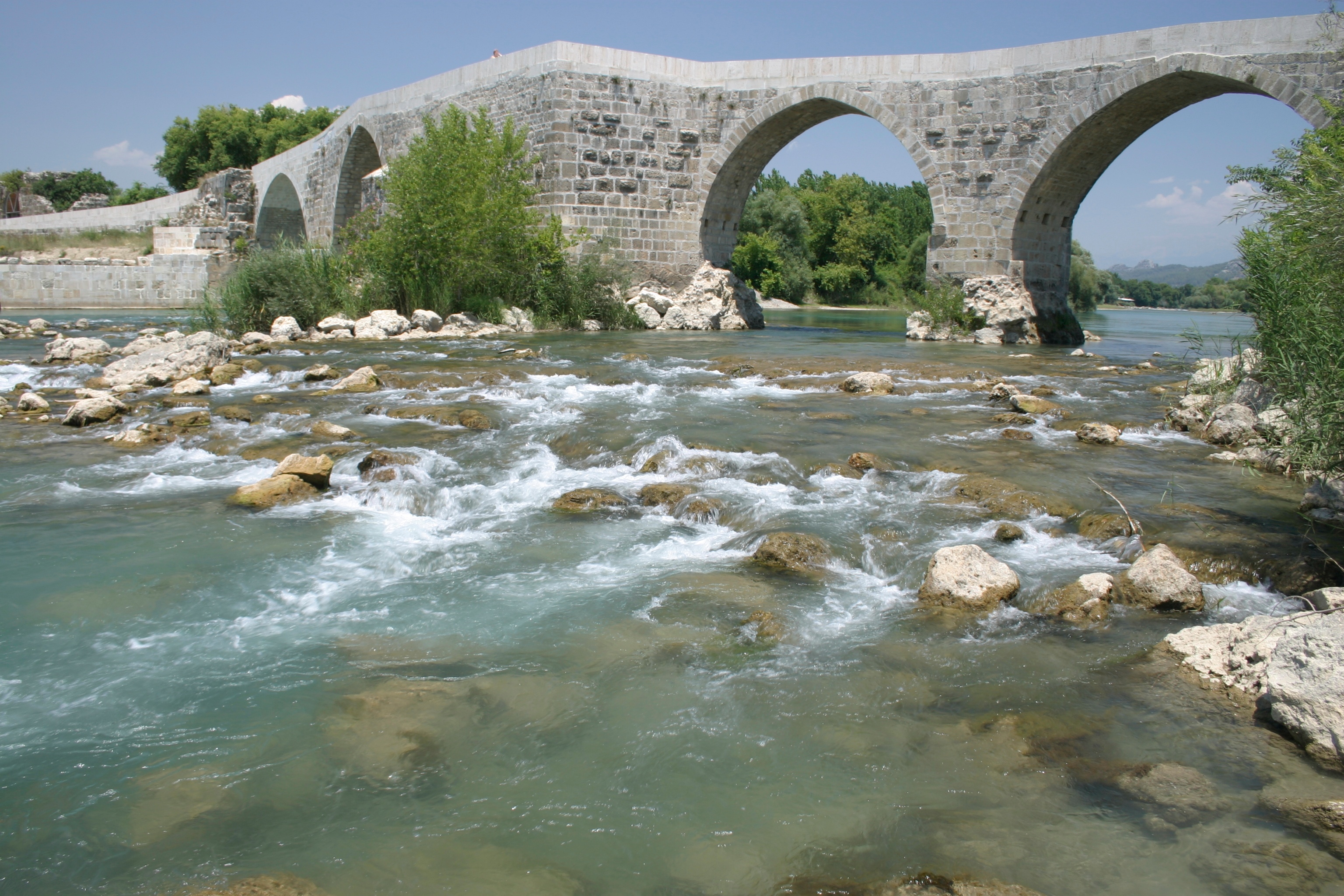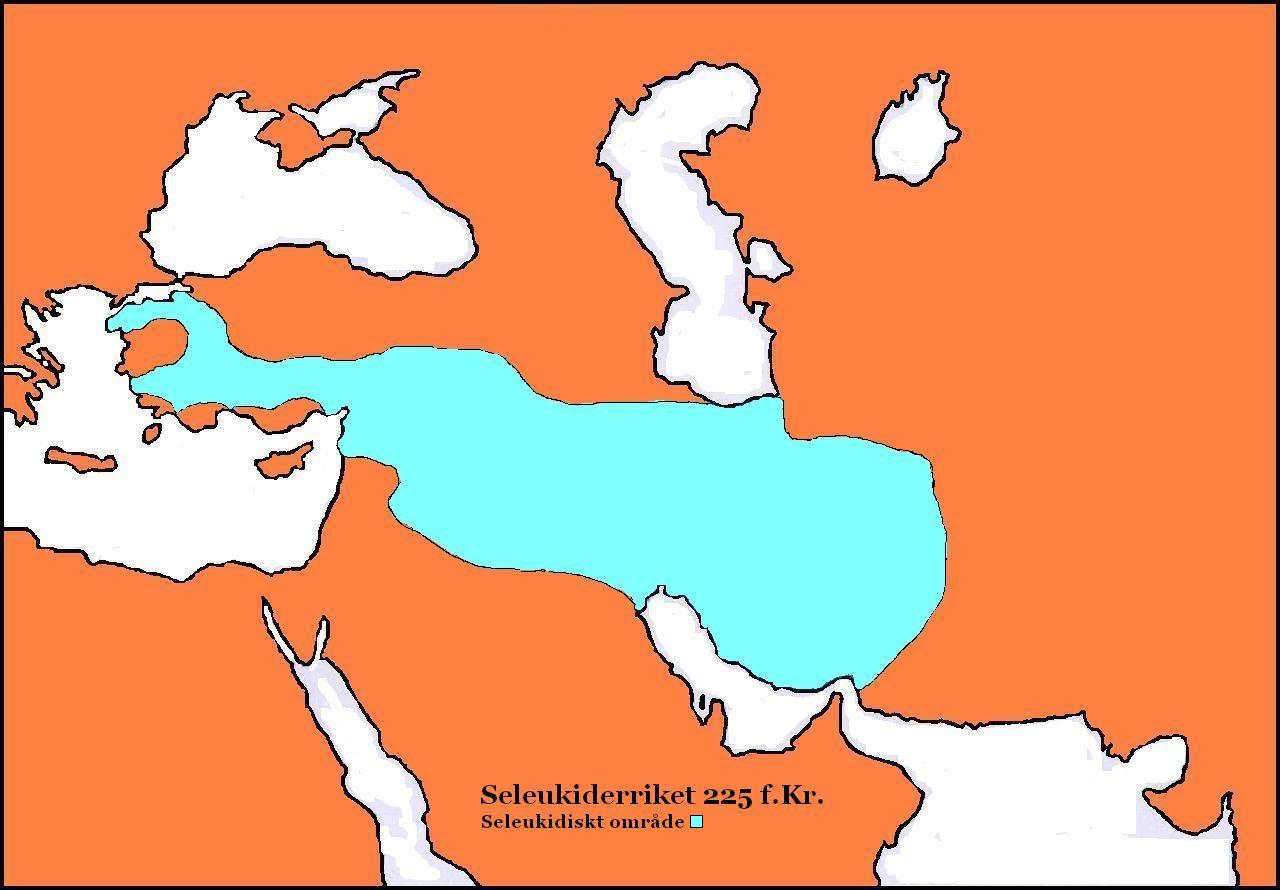|
Köprüçay River
Köprüçay, ancient Eurymedon (Ancient Greek: Εὐρυμέδων) is a river that is situated in Antalya Province, Turkey, and empties into the Mediterranean. At its mouth, in the 460s BC (the actual date is highly disputed), the Athenian general Cimon defeated a large Persian force of ships and men moving westwards (Battle of the Eurymedon). The two land and sea battles lasted one day and included Cimon's capture or destruction of the entire Phoenician fleet of 200 triremes. In 190 BC, a Roman fleet led by Lucius Aemilius Regillus defeated the Seleucid fleet of Antiochus III the Great, led by Hannibal, near the river. Strabo records a lake he called Caprias near its mouth although the area is today a salt marsh. The Seljuk-era Eurymedon Bridge, which rests on Roman foundations, crosses the river at Aspendos. Further upstream, half-way on the road to ancient Selge Selge ( el, Σέλγη) was an important city in ancient Pisidia and later in Pamphylia, on the southern slo ... [...More Info...] [...Related Items...] OR: [Wikipedia] [Google] [Baidu] |
Eurymedon Bridge, Selge, Turkey
Eurymedon may refer to: Historical figures *Eurymedon (strategos) (died 413 BC), one of the Athenian generals (strategoi) during the Peloponnesian War *Eurymedon of Myrrhinus, married Plato's sister, Potone; he was the father of Speusippus * Eurymedon the hierophant, the representative of Eleusinian Demetra; together with the school of Isocrates and Demophilos they brought a charge of impiety against Aristotle Greek mythology *Eurymedon (mythology) Geography *Eurymedon River, now Köprüçay River * Eurymedon Bridge (Aspendos), over this river at Aspendos * Eurymedon Bridge (Selge), over this river at Selge Other uses * 5012 Eurymedon, asteroid *''The Eurymedon'', alternative name for '' New Zealand Shipping Co. Ltd. v. A. M. Satterthwaite & Co. Ltd.'' court case * Eurymedon vase, an Attic red-figure ''oinochoe'', a wine jug attributed to the circle of the Triptolemos Painter made ca. 460 BC, which is now in the ''Museum für Kunst und Gewerbe Hamburg'' (1981.173) See ... [...More Info...] [...Related Items...] OR: [Wikipedia] [Google] [Baidu] |
Lucius Aemilius Regillus
Lucius Aemilius Regillus (fl. c. 190 – 189 BC) was a Roman admiral and praetor during the war with Antiochus III of Syria. Born to Marcus Aemilius Regillus, much of Lucius Regillus's early life and military career is unknown before being appointed commander of Roman naval forces in the Aegean Sea in 190 BC. That same year, supported by a flotilla from Rhodes, Regillus defeated a Syrian fleet commanded by former Carthaginian General Hannibal (his first, and subsequently last naval battle) at the Battle of Eurymedon and, after defeating a second Syrian fleet at the Battle of Myonessus secured the Aegean Sea under the control of Rome and its Rhodian and Pergamene allies. Upon his return to Rome in 189 BC, Regillus had a temple built in honor of the ''lares permarini Largo di Torre Argentina is a square in Rome, Italy, with four Roman Republican temples and the remains of Pompey's Theatre. It is in the ancient Campus Martius. The name of the square comes from the ''Torre Argenti ... [...More Info...] [...Related Items...] OR: [Wikipedia] [Google] [Baidu] |
Eurymedon Bridge (Selge)
The Eurymedon Bridge ( tr, Oluk Köprü) is a Roman bridge over the river Eurymedon (modern Köprüçay River) near Selge in Pisidia in southern Turkey. It is part of the road winding up from the coastal region Pamphylia to the Pisidian hinterland. Located 5 km north of the village Beşkonak in a sparsely settled area, the bridge crosses the Eurymedon high above the valley bottom. The excellently preserved structure is 14 m long and 3.5 m wide (with a roadway of 2.5 m). The clear span of its single arch is c. 7 m, the thickness of its voussoirs, which were set without the use of mortar, 60 cm. The building technique and the sturdy stonework point to a construction date in the 2nd century AD, a time when Selge was flourishing. Forty-two km downstream at Aspendos, the Eurymedon is crossed by another extant old bridge. Gallery File:Eurymedon Bridge 5066.jpg, File:Eurymedon Bridge 5058.jpg, File:Eurymedon Bridge 5051.jpg, File:Köprülü Kanyon ... [...More Info...] [...Related Items...] OR: [Wikipedia] [Google] [Baidu] |
Selge, Pisidia
Selge ( el, Σέλγη) was an important city in ancient Pisidia and later in Pamphylia, on the southern slope of Mount Taurus, modern Antalya Province, Turkey, at the part where the river Eurymedon River ( tr, Köprüçay) forces its way through the mountains towards the south. History The town was believed to be a Greek colony, for Strabo states that it was founded by Spartans, but adds the somewhat unintelligible remark that previously it had been founded by Calchas. Stephanus of Byzantium at the Ethnica, also, write that the city was a Lacedaemon colony. The acropolis of Selge bore the name of Kesbedion. The district in which the town was situated was extremely fertile, producing abundance of oil and wine, but the town itself was difficult of access, being surrounded by precipices and beds of torrents flowing towards the Eurymedon and Cestrus (today Aksu), and requiring bridges to make them passable. In consequence of its excellent laws and political constitution, Selge rose t ... [...More Info...] [...Related Items...] OR: [Wikipedia] [Google] [Baidu] |
Aspendos
Aspendos or Aspendus ( Pamphylian: ΕΣΤϜΕΔΥΣ; Attic: Ἄσπενδος) was an ancient Greco-Roman city in Antalya province of Turkey. The site is located 40 km east of the modern city of Antalya. It was situated on the Eurymedon River about 16 km inland from the Mediterranean Sea; it shared a border with, and was hostile to, the ancient city of Side. History The wide range of its coinage throughout the ancient world indicates that, in the 5th century BC, Aspendos had become the most important city in Pamphylia. At that time, according to Thucydides, the Eurymedon River was navigable as far as Aspendos, and the city derived great wealth from a trade in salt, oil and wool. Aspendos did not play an important role in antiquity as a political force. Its political history during the colonisation period corresponded to the currents of the Pamphylian region. Within this trend, after the colonial period, it remained for a time under Lycian hegemony. In 546 B ... [...More Info...] [...Related Items...] OR: [Wikipedia] [Google] [Baidu] |
Roman Empire
The Roman Empire ( la, Imperium Romanum ; grc-gre, Βασιλεία τῶν Ῥωμαίων, Basileía tôn Rhōmaíōn) was the post-Republican period of ancient Rome. As a polity, it included large territorial holdings around the Mediterranean Sea in Europe, North Africa, and Western Asia, and was ruled by emperors. From the accession of Caesar Augustus as the first Roman emperor to the military anarchy of the 3rd century, it was a Principate with Italia as the metropole of its provinces and the city of Rome as its sole capital. The Empire was later ruled by multiple emperors who shared control over the Western Roman Empire and the Eastern Roman Empire. The city of Rome remained the nominal capital of both parts until AD 476 when the imperial insignia were sent to Constantinople following the capture of the Western capital of Ravenna by the Germanic barbarians. The adoption of Christianity as the state church of the Roman Empire in AD 380 and the fall of the Western ... [...More Info...] [...Related Items...] OR: [Wikipedia] [Google] [Baidu] |
Eurymedon Bridge (Aspendos)
The Eurymedon Bridge was a late Roman bridge over the river Eurymedon (modern ''Köprüçay''), near Aspendos, in Pamphylia in southern Anatolia. The foundations and other stone blocks (''spolia'') of the Roman structure were used by the Seljuqs to build a replacement bridge in the 13th century, the Köprüpazar Köprüsü, which stands to this day. This bridge is characterized by a significant displacement along its mid-line, noticeable by looking at its ancient piers. Roman bridge Structure The original shape and construction of the Roman-era bridge have been reconstructed digitally, based on the extant remains of the ancient structure: the ramps, the abutments, and foundations of the piers. Several pieces of the original bridge are scattered along the river bed on both banks, and were not used during reconstruction. Originally, the bridge had a length of 259.50 m and a width of 9.44 m, and had nine semicircular arches. It crossed the river at a basic 90-degr ... [...More Info...] [...Related Items...] OR: [Wikipedia] [Google] [Baidu] |
Salt Marsh
A salt marsh or saltmarsh, also known as a coastal salt marsh or a tidal marsh, is a coastal ecosystem in the upper coastal intertidal zone between land and open saltwater or brackish water that is regularly flooded by the tides. It is dominated by dense stands of salt-tolerant plants such as herbs, grasses, or low shrubs. These plants are terrestrial in origin and are essential to the stability of the salt marsh in trapping and binding sediments. Salt marshes play a large role in the aquatic food web and the delivery of nutrients to coastal waters. They also support terrestrial animals and provide coastal protection. Salt marshes have historically been endangered by poorly implemented coastal management practices, with land reclaimed for human uses or polluted by upstream agriculture or other industrial coastal uses. Additionally, sea level rise caused by climate change is endangering other marshes, through erosion and submersion of otherwise tidal marshes. However, recent ackn ... [...More Info...] [...Related Items...] OR: [Wikipedia] [Google] [Baidu] |
Strabo
Strabo''Strabo'' (meaning "squinty", as in strabismus) was a term employed by the Romans for anyone whose eyes were distorted or deformed. The father of Pompey was called "Pompeius Strabo". A native of Sicily so clear-sighted that he could see things at great distance as if they were nearby was also called "Strabo". (; el, Στράβων ''Strábōn''; 64 or 63 BC 24 AD) was a Greek geographer, philosopher, and historian who lived in Asia Minor during the transitional period of the Roman Republic into the Roman Empire. Life Strabo was born to an affluent family from Amaseia in Pontus (in present-day Turkey) in around 64BC. His family had been involved in politics since at least the reign of Mithridates V. Strabo was related to Dorylaeus on his mother's side. Several other family members, including his paternal grandfather had served Mithridates VI during the Mithridatic Wars. As the war drew to a close, Strabo's grandfather had turned several Pontic fortress ... [...More Info...] [...Related Items...] OR: [Wikipedia] [Google] [Baidu] |
Hannibal
Hannibal (; xpu, 𐤇𐤍𐤁𐤏𐤋, ''Ḥannibaʿl''; 247 – between 183 and 181 BC) was a Carthaginian general and statesman who commanded the forces of Carthage in their battle against the Roman Republic during the Second Punic War. He is widely regarded as one of the greatest military commanders in history. Hannibal's father, Hamilcar Barca, was a leading Carthaginian general during the First Punic War. His younger brothers were Mago and Hasdrubal; his brother-in-law was Hasdrubal the Fair, who commanded other Carthaginian armies. Hannibal lived during a period of great tension in the Mediterranean Basin, triggered by the emergence of the Roman Republic as a great power with its defeat of Carthage in the First Punic War. Revanchism prevailed in Carthage, symbolized by the pledge that Hannibal made to his father to "never be a friend of Rome". In 218 BC, Hannibal attacked Saguntum (modern Sagunto, Spain), an ally of Rome, in Hispania, sparking the Second Pun ... [...More Info...] [...Related Items...] OR: [Wikipedia] [Google] [Baidu] |
Antiochus III The Great
Antiochus III the Great (; grc-gre, Ἀντίoχoς Μέγας ; c. 2413 July 187 BC) was a Greek Hellenistic king and the 6th ruler of the Seleucid Empire, reigning from 222 to 187 BC. He ruled over the region of Syria and large parts of the rest of western Asia towards the end of the 3rd century BC. Rising to the throne at the age of eighteen in 222 BC, his early campaigns against the Ptolemaic Kingdom were unsuccessful, but in the following years Antiochus gained several military victories and substantially expanded the empire's territory. His traditional designation, ''the Great'', reflects an epithet he assumed. He also assumed the title ''Basileus Megas'' (Greek for "Great King"), the traditional title of the Persian kings. A militarily active ruler, Antiochus restored much of the territory of the Seleucid Empire, before suffering a serious setback, towards the end of his reign, in his war against Rome. Declaring himself the "champion of Greek freedom against Roman domina ... [...More Info...] [...Related Items...] OR: [Wikipedia] [Google] [Baidu] |
Roman Navy
The naval forces of the Ancient Rome, ancient Roman state ( la, Classis, lit=fleet) were instrumental in the Roman conquest of the Mediterranean Basin, but it never enjoyed the prestige of the Roman legions. Throughout their history, the Romans remained a primarily land-based people and relied partially on their more nautically inclined subjects, such as the Greeks and the Egyptians, to build their ships. Because of that, the navy was never completely embraced by the Roman state, and deemed somewhat "un-Roman". In antiquity, navies and trading fleets did not have the logistical autonomy that modern ships and fleets possess, and unlike modern naval forces, the Roman navy even at its height never existed as an autonomous service but operated as an adjunct to the Roman army. During the course of the First Punic War, the Roman navy was massively expanded and played a vital role in the Roman victory and the Roman Republic's eventual ascension to hegemony in the Mediterranean Sea. In th ... [...More Info...] [...Related Items...] OR: [Wikipedia] [Google] [Baidu] |









